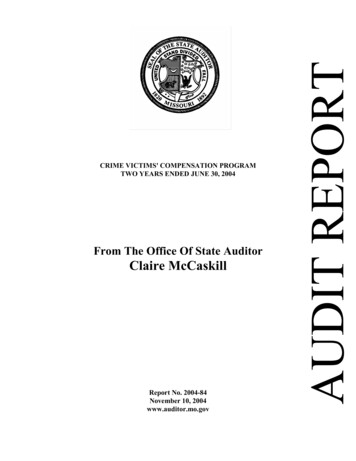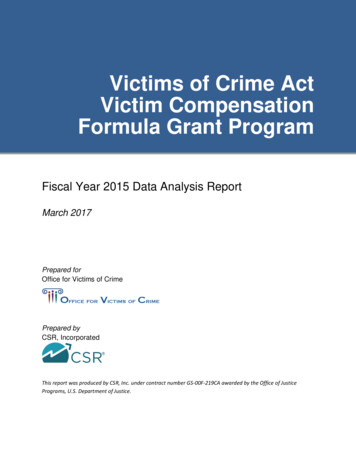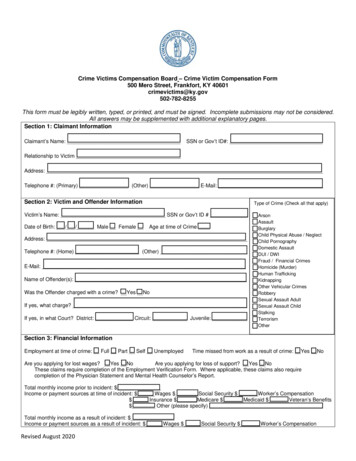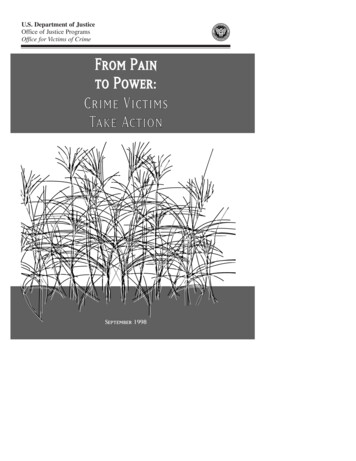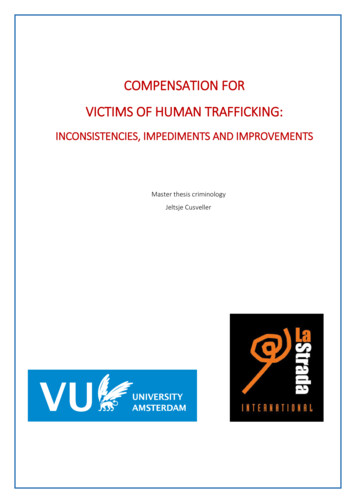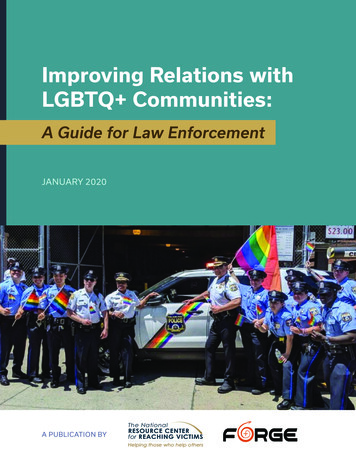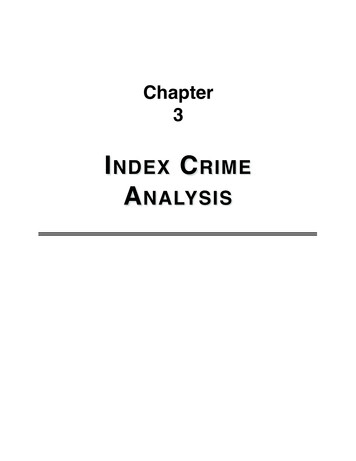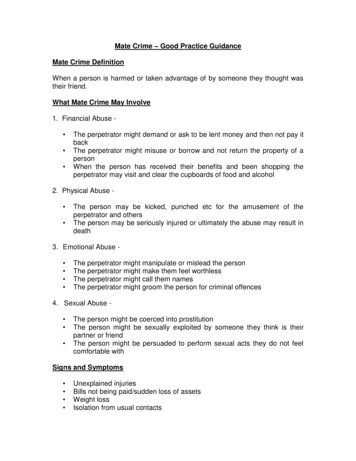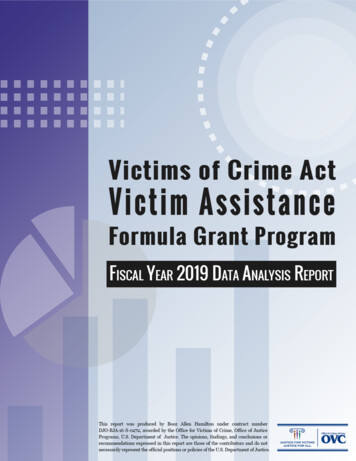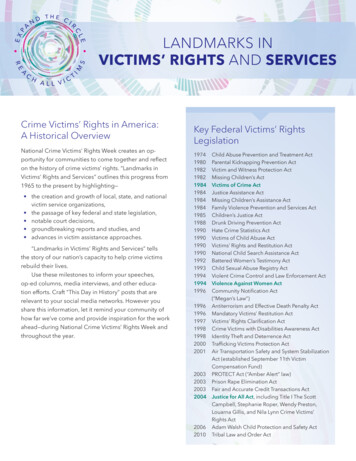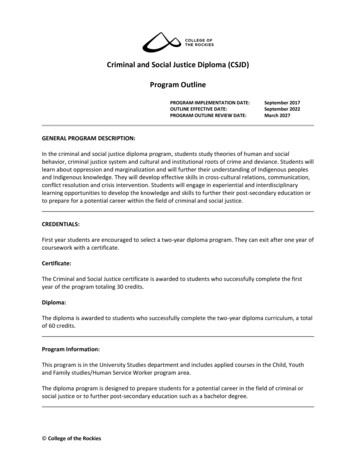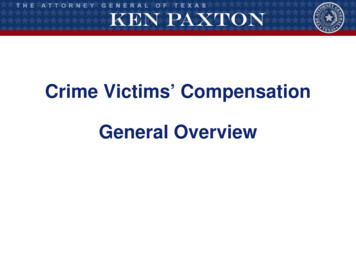
Transcription
Crime Victims’ CompensationGeneral Overview
Crime Victim ServicesMission StatementTo assist in the compassionate and effectivedelivery of crime victim services by offeringinformation, resources, financial assistance, andeducation to crime victims and the organizationsassisting them.
CVC Goal The goal of CVC is to reimburse victims of crime for certainout-of-pocket expenses not reimbursed by other sources. The Office of the Attorney General shall award to victimsand claimants compensation for pecuniary loss arising fromcriminally injurious conduct.
Enabling Legislation Texas Code of Criminal Procedure Article 56 subchapter B Article 56.31 through 56.64 Crime Victims’ Compensation Act CVC began January 1, 1980
CVC Mandates A victim has the RIGHT to request and receiveinformation about Crime Victims’ Compensation. Texas Code of Criminal Procedure, Article 56.02 (a)(6)and TFC, 7.002(6)
CVC Mandates T.C.C.P. Art. 56.07 Law Enforcement Mandate Initial contact with victim Written notice T.C.C.P. Art. 56.08 District and County Attorneys 10-day written notice Assistance with application T.C.C.P. Art. 56.60 Public Notice Posters in hospital emergency rooms
CVC Funding It is not a tax-based or general-revenue-funded program.No tax dollars are used. Sources of funding in FY 2017 were: Court fees Federal VOCA grant Restitution Subrogation Other receipts Gifts
Restitution CVC pays benefits to an eligible victim. At some point, an offender is apprehended and convicted. At sentencing, the judge can order the defendant to payrestitution to the CVC Fund for what the victim was paid ineligible benefits.
Subrogation CVC pays benefits to, or on behalf of, a victim. Victim files and wins a civil lawsuit for damages orreceives a settlement from perpetrator. Victim reimburses funds to CVC for lawsuits andsettlements related to the crime. Victim and his/her attorney are subject to prosecution forfailure to notify CVC.
Payer of Last Resort All collateral sources must pay first: Medicaid Health insurance Medicare Texas Workers’ Compensation Auto insurance
CVC Fiscal Year 2017 Summary 64.2 million in payments Received a total of 34,813 applications and sexualassault exam reimbursement claims 24,306 were victim compensation applications 10,507 were sexual assault reimbursement claims
VictimWho is a victim? An individual who suffers physical or mental harm or deathas a result of criminally injurious conduct Note that every application has to have one victim, andonly one victim Includes peace officers, firefighters or individuals whoseemployment duty is to protect the public
ClaimantWho is a claimant? An authorized individual acting on behalf of a victim An individual who legally or voluntarily assumes theobligation to pay expenses A dependent of a deceased victim An immediate family or household member who requirespsychiatric care or counseling An application can have multiple claimants, but only onevictim
Eligibility (1 of 3)Who is eligible to receive CVC? A Texas or U.S. RESIDENT who becomes a victim ofcrime in Texas A Texas resident who becomes a victim in a country withno benefits A Texas resident who becomes a victim of a crimedefined as an act of terrorism committed outside theUnited States (as of September 1, 1997)
Eligibility (2 of 3)RESIDENT as used in the Texas Code Criminal ProcedureART. 56.32(a)(11)(A)(ii), the term means a person who has adomicile in Texas or who lives for more than a temporary periodin Texas, another state or the U.S., the Dist. Of Columbia, theCommonwealth of Puerto Rico, or a possession or territory ofthe U.S.
Eligibility (3 of 3) A Social Security number is not required for avictim to apply and be eligible for the CVC Program. A tax ID or Social Security number is a requirementto receive a payment.
Criminally Injurious Conduct“Criminally injurious conduct” refers to crimes that: Are attempted or occur Pose a substantial threat of personal injury Would be punishable by fine or imprisonment
CIC CrimesEligible for Reimbursement (1 of 2) Criminal injurious conduct (CIC) crimes are violent crimesagainst persons. CIC crimes range from simple assault to homicide and includesuch crimes as family violence, child sexual assault,kidnapping, arson, robbery and carjacking.
CIC CrimesEligible for Reimbursement (2 of 2) CIC vehicular related crimes are: Crimes of intentional injury with an automobile,boat, or plane Failure to stop and render aid (hit and run) Vehicular crimes involving drugs or alcohol Intoxication-related crimes (assault, manslaughteror criminally negligent homicide)
Denial or ReductionBehavior Factors If the person Was engaged in illegal activity (deny or reduce) Shares in the responsibility for the crime(deny or reduce) Fails to cooperate with law enforcement and prosecutionefforts (deny) Possible factors Entire situation is reviewed
CVC Requirements There is no requirement that a suspect be Identified Apprehended Charged Convicted for a victim to apply for and be awarded compensation. There is a requirement for the victim to cooperatethroughout the criminal justice process.
CVC Reporting Requirements Reporting the crime to law enforcement 72 hours prior to September 1, 1997 On or after September 1, 1997, a reasonable period of time, butnot so late as to interfere with or hamper the investigationand prosecution The program has the discretion. The victim is a child. Extraordinary circumstances hampered the reporting
CVC Filing Requirements Filing requirements to CVC program Prior to September 1, 1997, one year On or after September 1, 1997, three years Exceptions Good cause Child victim through age 18 (pre-1997) Child victim age 18 to 21 (1997-present) Victim physically incapacitated
Application (1 of 2) The CVC application (English and Spanish) is available onour web page. The application is always reviewed after a legislativesession to assure it meets statutory requirements.An application is considered complete and will beprocessed when it: Is filled out in its entirety Is signed by a victim or a valid adult claimant Provides law enforcement information Provides any other information requested by the OAG
Application (2 of 2)
Awards Up to: 25,000 for crimes prior to September 1, 1997 50,000 for crimes on or after September 1, 1997 For reimbursement of medical costs, counseling, lost wages,funeral costs, and other costs resulting from the crime Does not include property loss or damage
Award Types Medical(includes psychiatric care/counseling and dental) Loss of earnings Loss of support Funeral and burial Relocation and rental Child or dependent care Crime Scene clean-up Property seized as evidence TravelFor dates of crime on or after July 15, 2016 there are NEW benefitlimits.
Medical ExpensesIncludes: Hospital expenses Doctors’ fees Prescriptions Emergency room Ambulance X-rays Rehabilitation Nursing home Dental
Medical Expenses Medical expenses are paid according to the Division of Workers’Compensation medical fee guidelines and are based on the dates ofservices rendered. If the victim pays the medical bills, they will be reimbursed theiractual cost. The victim is not responsible for the difference, unless the victim hadbenefits reduced or the claim is found to be a “med max.” Example: medical bills total cost that exceed the amountavailable for a claim. Medical expenses are only limited by the funding available in theclaim. Reimbursements for medical expenses must be submitted withinthree years of the date of service, unless extenuating circumstancesexist.
Mental Health Inpatient psychiatric care or counseling Victim only 600 per day (before September 1, 2014) After September 1, 2014, expenses paid at themedical fee guideline Maximum 30-day stay; unless good cause is shown Should be pre-authorized Outpatient psychiatric care or counseling 60 sessions for victim 60 sessions for claimant
CVC EligibleMental Health Providers Eligible providers must be licensed mental healthproviders limited to the following professions which are updatedon the CVC web page: Psychiatrist, and other M.D. Clinical Psychologist Clinical Nurse Specialists in Psychiatry (CNS) Licensed Professional Counselor (LPC) Licensed Marriage and Family Therapist (LMFT) Licensed Clinical Social Worker (LCSW) CVC does not make referrals to victims seeking treatment;they are referred to their local resources.
Travel Travel expenses due to participation in or attendance at: The investigation prosecution, or judicial processes; alsopost-conviction and post-adjudication-involvement The execution of the perpetrator Seeking necessary medical treatment and counselingservices The funeral of the victim for immediate family andhousehold members
Travel Exceeds 20 miles (one way) Necessary and reasonable transportation Commercial transportation Personal vehicle / state mileage reimbursement rate Exceeds 60 miles (one way) Meals and lodging expenses Meals and lodging are per diem state rate Commercial transportation Personal vehicle / state mileage reimbursement rate Different travel rates apply for different years and are basedon the state rate at the time.
Loss of Earnings Loss of Earnings related to medical: Physical or emotional disability (victim) While seeking medical treatment for crime-related injury(victim) Care for a medically incapacitated adult/minor child (claimant) Attending counseling for crime related injury (victim orclaimant) Loss of Earnings related to the criminal justice system:Police investigation appointments (victim or claimant) Protective order court appointment Criminal proceedings Post-conviction Post-adjudication proceedings (executions) Loss of Earnings related to victim’s funeral
Loss of Earnings If employed, weekly net earnings are multiplied by thedisability period. Limited to 700 per week If unemployed, CVC will consider situations that demonstratethe victim would have been employable. Benefits would bebased on anticipated loss of future earnings.
Loss of Support To dependents of a murder victim Up to 50,000 To dependents of surviving victims Usually family violence Limited to 13 continuous weeks To dependents of a medically disabled victim During disability period Limited to 700 per week Verification of dependency, support lost and collateral sources
Funeral and Burial Funeral and burial expenses maximum of 6,500 Additional funds available to transport the body What is covered: Funeral services Casket, urn Graveside services Cemetery expenses Marker/headstone Cremation charges Additional costs such as flowers, burial clothing for thedeceased, exhumation and reburial
Relocation (1 of 4)For victims of : Family violence (June 19, 1999)Sexual Assault in their residence (September 1, 2001)Human trafficking (September 1, 2013)Stalking (September 1, 2015) 3,800 total benefit Up to 2,000 for applicable relocation costs: Transportation Deposits and fees Moving van and storage Three months rent up to 1,800 One-time award 3 year time limit to apply for relocation
Relocation (2 of 4) For victims of sexual assault in their residence (September1, 2001) “Sexual assault “ means an offense under Section 21.02,21.11(a)(1), 22.011, or 22.021, Penal Code.
Relocation (3 of 4) For victims of family violence (June 19, 1999) Proof of cohabitationSec. 71.004. FAMILY VIOLENCE. "Family violence" means:(1) an act by a member of a family or household against anothermember of the family or household that is intended to result inphysical harm, bodily injury, assault, or sexual assault or that is athreat that reasonably places the member in fear of imminent physicalharm, bodily injury, assault, or sexual assault, but does not includedefensive measures to protect oneself.
Relocation (4 of 4) For victims of human trafficking (September 1, 2013)Sec. 20A.02. TRAFFICKING OF PERSONS. (a) A person commitsan offense if the person knowingly:(1) traffics another person with the intent that the traffickedperson engage in forced labor or services;(2) receives a benefit from participating in a venture thatinvolves an activity described by Subdivision (1), including byreceiving labor or services the person knows are forced laboror services;(3) traffics another person and, through force, fraud, orcoercion, causes the trafficked person to engage in conduct
Child or Dependent Care Only available as a NEW EXPENSE resulting from the crime Children (14 years and under) or dependent adults Care must be provided by licensed or registered provider 300 per week per child or dependent Crime dates after May 7, 2005 child care is limited to 90 days Crime dates on or after July 15, 2016 child care is limitedto 1 year 90 day child care exception for dependents of deceasedvictims
Crime Scene Clean-Up Reasonable and necessary costs of cleaning thecrime scene 2,250 limit Commercial cleaning company Will reimburse for cleaning supplies when work is doneby volunteers
Property Seized as Evidence Reasonable replacement costs for clothing, bedding, orproperty of the victim seized as evidence or renderedunusable as a result of the criminal investigation 1,000 limit This is the only property for which reimbursement can bepaid by CVC.
Extraordinary Pecuniary Loss Extraordinary pecuniary loss is a total and permanentdisability. Above the base award the EPL benefit is Additional 25,000(for crimes occurring September 1995-97) Additional 50,000(for crimes occurring on or afterSeptember 1, 1997 to August 31, 2001) Additional 75,000(for crimes occurring on or after September 1, 2001)
Extraordinary Pecuniary LossTotal and Permanent Disability Durable medical equipmentRehabilitation technologyNursing home careHome and Auto adaptionsVocational RehabilitationHome health careTraining in the use of special appliancesLoss of earningsJob training
Appeals Process The victim or claimant has the right to appeal a decision(eligibility or awards) Reconsideration Final Ruling Hearing District Court
Claim Closure Due to Fraud Texas Code of Criminal Procedure, Article 56.41 (b)(7)(b) The attorney general shall deny an application forcompensation under this subchapter if: (7) the claimant orvictim knowingly or intentionally submits false or forgedinformation to the attorney general. Texas Code of Criminal Procedure, Article 56.38 (b)The attorney general may investigate an application. Texas Code of Criminal Procedure, Article 56.47(a)The attorney general, on the attorney general’s own motion,or on request of a claimant or victim, may reconsider;(1) a decision to make or deny an awards; or(2) the amount of the award
Claim Closure Due to Fraud Loss of earningsScenario 1 Victim was awarded loss of earnings. CVC received information that victim submitted two falseemployment verification documents and also forged HRDirector’s signature to falsely show they were employed. Victim was charged and arrested for tampering with agovernmental record.Scenario 2 Victim submitted false medical documentation in order tocontinuing receiving loss of Earnings. Victim, a nurse, had been terminated from his/her jobdue to felony forgery convictions, but falsely indicatedthat it was due to a crime-related injury.
Claim Closure Due to Fraud RelocationScenario 1 Victim awarded relocation, but claimed she neverreceived the check. CVC processed a stop payment and issued a 2nd check. Comptroller’s records revealed both checks had beencashed. Victim was charged with theft.Scenario 2 Victim submitted a falsified lease. CVC called apartment complex and was advised victimwas not approved. Victim was charged with tampering with a governmentalrecord.
CVC Claims Management System Remote User Access in the CVC Claims Management Systemis now referred to as the CVC Web portal. CVC Secure Web portal is a tool applicable users can accessto view basic CVC claim information via the Internet. There are three levels of security access to CMS: Service Providers Law Enforcement Non-Profit Victim Advocates
CVC Claims Management System All CMS users are able to view general case information. Service provider accounts allow the user to view only thoseclaims for which they have provided services based ontheir tax ID. Law enforcement and advocate accounts allow the user toview general billing information and case notes. If you would like to access the new web portal, yourorganization’s contact person must complete a neworganization application. Once the organization has been approved, individual userscan complete a new user application.
OAG Website for CVC OAG website for Crime Victim’s Compensation www.oag.texas.gov What is available on the CVC website? General program information Basic qualification requirements Reimbursable expenses How to apply Forms and applications Appealing a denial Remote User / Claims Management System Information for service providers Publications and materials order Training
Other Programs Available (1 of 3)Sexual Assault Exam Reimbursement Program Reimburse law enforcement for the reasonable costs of asexual assault examination of a victim Full details and application at OAG website A separate claims process from victim CVC claim Contact person: Roxanne Ramon (512) 936-1920
Other Programs Available (2 of 3)Address Confidentiality Program Texas Code of Criminal Procedure Articles 56.81-56.93 ACP assists victims of family violence, sexual assault andstalking, aiding in effort to keep victim’s address confidential. Works in conjunction with victim’s existing safety plan
Other Programs Available (3 of 3)Address Confidentiality ProgramFor more information contact:Office of the Attorney GeneralAddress Confidentiality Program (ACP)P.O. Box 12199 MC ProgramAustin, Texas 478711-2199www.crimevictims@oag.texas.gov(512) 936-1750(888) 832-2322
For More InformationOffice of the Attorney GeneralCrime Victim Services DivisionCVC ProgramP.O. Box 12198Austin, TX 78711-2198www.oag.texas.gov(512) 936-1200 or (800) 983-9933 Main Number(512) 320-8270 General Fax NumberNational Association of Crime Victim Compensation Board website has links toeach state’s CVC programwww.nacvcb.org
CERTIFICATE of PARTICIPATIONThe Office of the Attorney General presents this certificate to:(Print your name)with sincere appreciation for your on-line trainingon this day of , 20of theCVC General Overview(Signature of participant )Mail a copy of your certificate to :Crime Victim Services DivisionAttention: Training & Outreach CoordinatorP O Box 12198Austin, Texas 78711-2198
information about Crime Victims' Compensation. Texas Code of Criminal Procedure, Article 56.02 (a)(6) and TFC, 7.002(6) CVC Mandates . restitution to the CVC Fund for what the victim was paid in eligible benefits. Subrogation CVC pays benefits to, or on behalf of, a victim.
